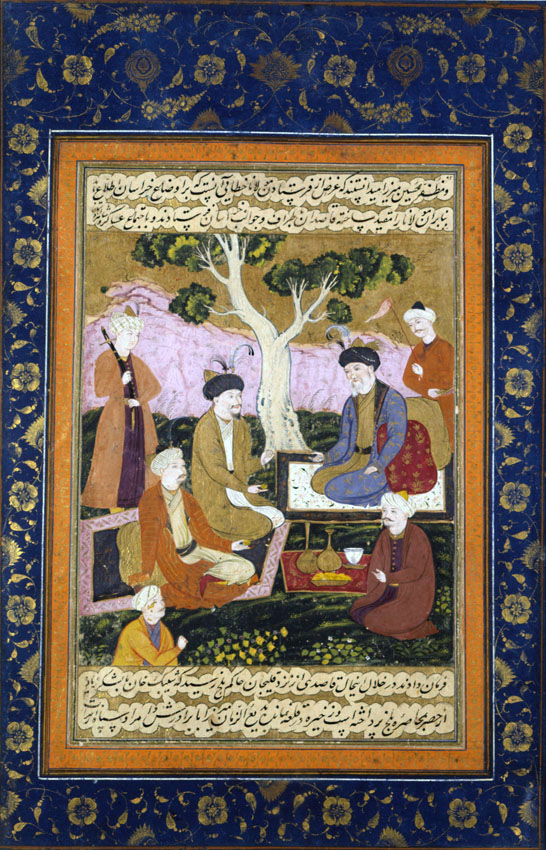Location: Present Whereabouts Unknown.
Mount: Blue mount with orange collar. Size of mount not known.
Written surface:: 23.4 x 15.2 cm.
Painting: 17.8 x 15.2 cm.
Text references: J.K., p.339 lines 5 to 8.
See Muntaẓer-Ṣāḥeb_1970, p.293 for this event in the History of Shah Esmāʿil.
See Savory, SA_1979, p.59 for this event in the History of Shah ʿĀbbās.
Date of this event: 915/1508. The History of Shah ʿĀbbās differs, stating that it took place in 913/1507.
Sultan Ḥoseyn Mirzā Bāyqarā, the last Timurid ruler of Herat, had three sons, Badiʿ al-Zamān Mirzā, Moẓaffar Ḥoseyn Mirzā, and Köpek Mirzā, who after the death of their father in 1505, had pretensions to independent rule. Upon hearing of the dissension and disagreement between the Timurid princes, Šāhibeg Ḵān (Moḥammad Khan Šibāni, the Uzbeg) coveted Khorasan and sent an ambassador, Mollanāh Ḵatāʿi to spy on what was going on at the court. Moẓaffar Ḥoseyn Mirzā, reaalizing the emissary's purpose, felt obliged to send out spies of his own. They returned in due course with a message from the Governor of Balkh, that Šāhibeg Ḵān had surrounded Balkh with a large army and the inhabitants were running out of provisions. Badiʿ al-Zamān Mirzā and his brothers assembled an army and marched to Balkh, where Šāhibeg Ḵān engaged them, defeated them, and put some of them to death. In short, he destroyed the last remnants of the Timurid dynasty and annexed their territory.
The portrayal of this event in Manuscript M, f.165, emphasizes much more the dissention between the princes and the ambassador, who is being physically restrained. Here the meeting is less contentious, almost taking on the aire of a picnic. The setting is outdoors, perhaps in a garden, with a lush green foreground, and a single tree, a pink ridge and gold sky in the background. There are four seated participants, the three sons of Sultan Ḥoseyn and Mollanāh Ḵatāʿi, but which is which is uncertain. Minute inscriptions on two of the personage are not legible enough to provide identifications, nor does Sotheby's reading of them does not help. Our guess would be that Mollanāh Ḵatāʿi is the white-bearded individual at 2 o'clock, and that the three sons Moẓaffar, Badiʿ and Köpek are represented in counter-clockwise order. Two ceremonial swordbearers are positioned in the upper left and right accordingly. Lastly, an individual in yellow at the bottom left, whose lower extremities are cropped by picture plane, is a typical device employed by Moʿin probably only for compositional purposes.
Painting references:
Sotheby’s London, 22 April 1999, Lot 51.
Photo courtesy of Sotheby's.
Robert Eng
Last Updated: September 20, 2012 | Originally published: September 20, 2012
